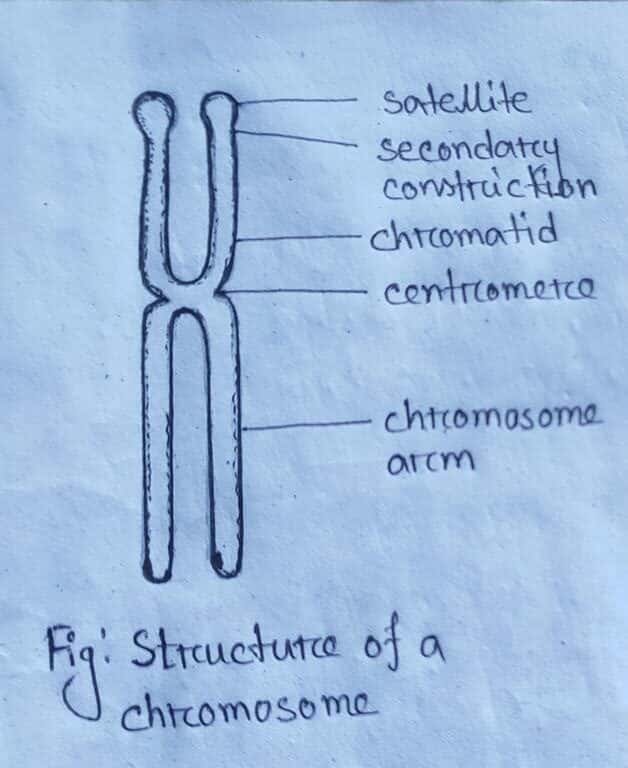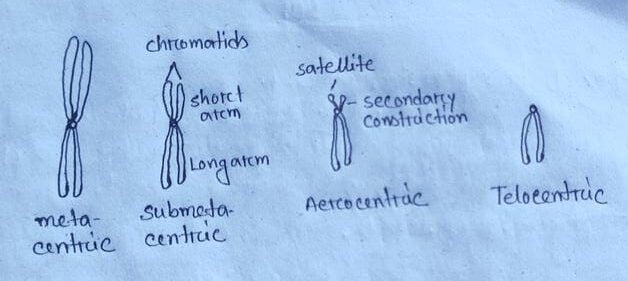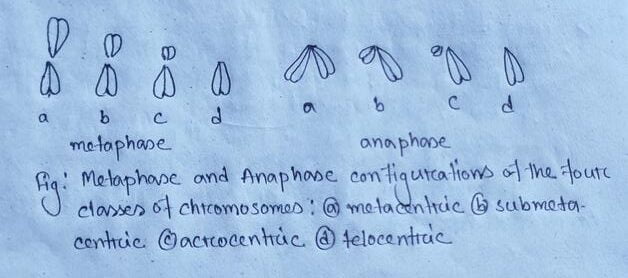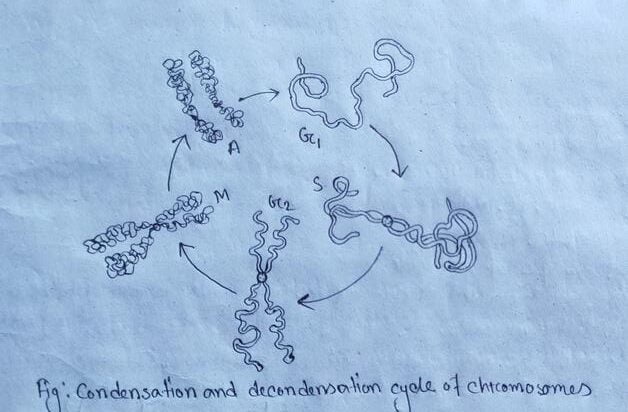Chromosomes are the principal component of the nucleus of higher plants. It contains genes that are arranged in a linear order and maintain hereditary stability. In the cell, the chromosome morphology looks like a coiled thread structure when nuclear division is started and becomes condensed at later stages.
brief History of chromosome morphology
The presence of chromosomes was first demonstrated by Strasburger (1875) and described as chromosome by Waldeyer (1888). The term ‘chromosome’ was first coined by Baranetsky.
Chromonema and Chromomere
The structure of chromosomes is a thread-like appearance, termed chromonema. This thread is beaded in appearance, the beads being termed as chromomeres.
The structure of chromosomes is fibrillar, made up of fibrils and folded several times to give thickness. The structure appears as coiled at the beginning of cell division which undergoes spiralization and condensation up to a stage, followed by successive despiralisation. The chromonema represents coiled thread and is the permanent component of the chromosome.

Chromatid
At the higher microscopic level, observation of chromosomes is dependent on the use of basic dyes. In the mid-phase of cell division, the chromosomes are highly condensed and spiralized and strongly respond to basic dyes, then chromosome structure analysis is practically very well-formed. Each chromosome at metaphase is made up of two symmetrical chromatids which are held together by the centromere and become separate at anaphase.

Construction – Primary and Secondary
The chromosomes appear as somewhat cyclical bodies at their dividing stages, by the usual methods of fixation and staining, constricted at one region or more along their lengths. The position of these constructions is constant characteristics of any particular chromosome of the complement. These structures are referred to as primary and secondary constrictions.
The primary constriction which is known as centromere is an essential part since chromosomes which lack the centromere cannot move to the poles during mitosis. The secondary constrictions referred to as NOR, responsible for the organization of nucleolus.
Centromere
The centromere is the region of the chromosome associated with the spindle in two poles during anaphase. The centromere forms: (i) final point of adhesion for the sister chromatids during metaphase to anaphase transition, (ii) attachment point for mitotic spindle fibres, (iii) site for motor protein to mediate chromosome movement.
The position of the centromere is a very important criterion for classifying chromosomes in different categories – such as chromosomes are described as metacentric, submetacentric, acrocentric, telocentric.

If the centromere is towards the middle, dividing the chromosomes into two equal arms, then chromosomes are known as metacentric; and when constrictions at the sub- median position that are called submetacentric and when towards the end that are called acrocentric, when centromere is located at the end of the arm, then known as telocentric. On the basis of the position of the centromere, the chromosomes look ‘V’ shaped, ‘L’ shaped, ‘J’ shaped, ‘I’ shaped respectively during anaphasic movement.

On the basis of the number of centromeres, chromosome may be monocentric (one centromere – usual), dicentric (two centromere – as in wheat), polycentric (many centromeres – as in Ascaris) or acentric (without centromere – does not survive).
Kinetochore
The kinetochore is the microtubule implantation site of the chromosome where spindle fibres are attached. Electron microscope studies have given further details of the structure of the kinetochore. These are trilaminar cups or plate-like structures of 0.20-0.25 nm diameter on either side of the centromeric construction.
In the cross-section, it has 3 layers – (1) an outer layer of dense material of 10nm thick, (2) a middle layer of lower density, (3) an inner dense layer in contact with the underlying chromatin fibres. kinetochore contains specialized DNA-protein complexes. These sequences contain the information specifying the assembly of the kinetochore.
NOR and Satellite
In addition to the centromere (primary constrictions), some of the chromosomes possess another constriction, termed as secondary constriction. This constriction is located almost at the end of the chromosome arm so that the terminal segment assumes a dot-like appearance, this type of chromosome is called SAT chromosome. The word satellite, though often widely used, is in a strict sense the end segment of the chromosome arm. This continuous thread represents the connecting link between the satellite and the main chromosome arm when it is often visible. This satellite segment is responsible for the nucleolus organization, thus it is called Nucleolus Organizing Region or NOR. As this segment contains genes coding for 18 S and 28 S ribosomal RNA, it is necessary for ribonucleoprotein metabolism. In some cases, chromosomes have more than one secondary constriction – then it is known as supernumerary constrictions.
Telomere
Telomeres are nucleoprotein structures and occur at the end portion of chromosomes. They perform several vital functions including end protection. Telomeres enable distinguishing between normal chromosome ends and breaks so that the cycle can be delayed to repair chromosome breaks. The chromosome’s end protection is mediated through a special mechanism involving telomerase – a reverse transcriptase. This compensates for the inability of DNA polymerase to replicate the chromosome completely. Normal DNA replication mechanisms cannot lead to complete telomere replication as they yield a blunt DNA end and the other end having 3′ overhang.
From the stability and complete replication process of the telomeres in higher organisms, indicate that they have certain several common features.
Telomeres play important roles –
- Required for the complete replication of the chromosome.
- From nucleases and other destabilizing influences protect the chromosomes.
- Prevent the ends of chromosomes from sticking with one another.
- They facilitate the interaction methods between the ends of the chromosomes and the nuclear envelope.
If you have any query regarding “chromosome morphology” post, then don’t hesitate to comment below.
what is chromosome morphology?
Chromosomes are the principal component of the nucleus of higher plants. It contains genes that are arranged in a linear order and maintain hereditary stability.
what is chromonema and chromomere in chromosome morphology?
The structure of chromosomes is a thread-like appearance, termed chromonema. This thread is beaded in appearance, the beads being termed as chromomeres.
what is centromere?
The centromere is the region of the chromosome associated with the spindle in two poles during anaphase.
what is kinetochore in chromosome morphology?
The kinetochore is the microtubule implantation site of the chromosome where spindle fibres are attached.

